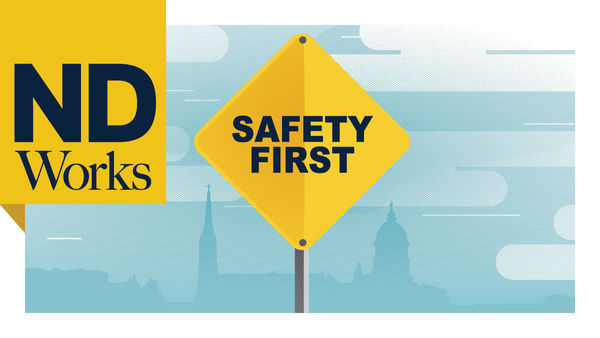

Recently, Marissa Gebhard sat down with Mike Seamon, vice president for Campus Safety and University Operations, to understand the measures the University takes to ensure the safety of the campus community, here and abroad. (Mike Seamon is pictured in the center of the photo, posing with some of his staff.)
NDW: What goes into providing a safe and secure environment here and abroad?
MS: On any given day, there may be anywhere from 20,000 to 150,000 people on campus. Our safety measures are scalable to fit what is happening on that particular day. We partner with the very best in the safety industries, consultants and agencies at the local, state, national and international levels to inform our safety strategies and our safety approach.
On the law enforcement side, we are in communication with our local partners of the city, county and state police, as well as various national security agencies, like the FBI, on what is happening in the world and how it could impact our community.
We collaborate with medical experts on cutting-edge technologies and how we can best care for people who get injured or become ill while on campus. We work with Indiana OSHA (Occupational Safety and Health Administration) and others on best practices in workplace safety. Our ultimate goal is to have everybody go home safe and in good health.
NDW: How does technology contribute to safety and security?
MS: Technology plays a significant part in safety, allowing us to see the big picture of what’s happening on campus. Our dispatch call center in Hammes Mowbray Hall is one of the most technologically advanced call centers in the state. Twenty four hours a day, 365 days a year, at least two people are tracking all incoming calls, dispatching Notre Dame Fire Department (NDFD), Notre Dame Police Department (NDPD), Risk Management and Safety and Facilities Operations teams, as needed. In the case of an emergency, our robust technologies and equipment allow us to send NDAlerts to our entire campus community immediately via texts, voicemails, emails and indoor and outdoor public address speakers.
Our fire trucks are designed to navigate our dense campus and connect with our sophisticated fire systems. Our smoke and heat detection systems are best in class. Information from the detectors is transmitted instantaneously to our dispatch center, police and fire departments and their vehicles to inform them of exactly what is happening and in which room of the building. We’re also deploying the best AED (automated external defibrillator) technology throughout campus, and we have the capability to transmit vital medical information directly to the emergency room before the ambulance arrives at the hospital.
In addition to these intelligent systems, our sophisticated Vapor Wake dogs — specifically trained to detect explosives on a moving target — and magnetometers (metal detectors) add new layers of security for our campus community. In essence, technology impacts everything we do.
NDW: How does the University prepare for emergencies?
MS: To complement our practice drills and training throughout the year, we engage with national emergency management consultants who specialize in emergency preparedness. We also collaborate with experienced partners in higher education that have experienced campus shootings — like Virginia Tech and MIT — and other safety industry partners to help inform our strategies and guide us.
On the local level, our police and fire personnel routinely train throughout the year with our partner agencies in the region, and we hold live drills and training sessions on and off campus to promote familiarity between departments. Their support under our unified command on (football home) game days and at other large events is crucial. We are very fortunate to have extremely strong relationships with our area emergency responders.
In addition to active shooter/violence, hazardous chemicals, bomb, fire, emergency medical, and water and ice rescue training, each spring we bring together 250 to 300 people from across campus to train them on what we would do in an elevated emergency situation.
NDW: How can we, as faculty and staff, help with safety and security?
MS: Safety is a shared responsibility, so we ask every member of the Notre Dame community to create and promote a culture of safety on campus. If you see something, say something. That might include a suspicious person, or an unsafe work condition, like a slippery surface, or something that simply doesn’t feel right. When you suspect something doesn’t feel or look right, call NDPD at (574) 631-5555 anytime, 24 hours a day, 365 days a year. We would rather have you call us a thousand times and have nothing happen, than not call us the one time something bad happens. Another thing you can do is partner with us. This is an open invitation. We are happy to visit any building, or any unit, and tailor a safety plan for that respective area.
Originally published by at ndworks.nd.edu on March 02, 2020.